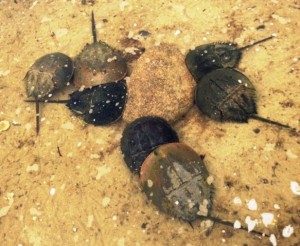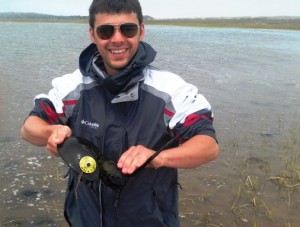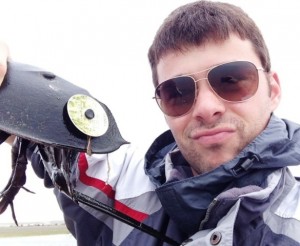It was a cool foggy spring day when I departed to do horseshoe crab surveys with Michael Sprague, another field researcher at Wellfleet Bay. We were asked to go to Marsh 2-3, an enigmatic name to say the least, a site where a lot of horseshoe crabs spawn in Pleasant Bay. As we approached the beach, the fog started to clear and as I focused on the shore, dozens of black dots emerged from the waves. Could it be possible that these were all horseshoe crabs? I had never seen so many in such a small area, and wondered how we were going to count all these in less than the required survey hour.
As we waited for the tide to recede I walked along the shore and just observed the crabs. I laughed to myself as I watched half a dozen males scramble to attach themselves to a large tan rock which, in their amorous mood, they thought was a female. And it wasn’t just large rocks they would pursue; I was constantly pushing them off of my boots and I even found a mound of males attached to our anchor!
For the actual survey we surveyed 22 five meter quadrats of beach (330 feet) and recorded just under 750 horseshoe crabs in 60 minutes! It was simply incredible, to say the least. For comparison, an equivalent survey in Wellfleet Harbor, where bait harvest of the crabs is allowed, would typically produce less than 10 crabs!
Then as we walked back to the boat something caught my eye. It was a small male horseshoe crab with a big white disk attached to his shell. I screamed, “THERE’S A TAGGED ONE!” I burst through the water trying to catch up to him before he could escape into deeper water. I reached down and picked him up, his legs fluttering in a wave-like motion. I was ecstatic because this was my first tagged crab and it was an older tag. His number was 132683, a number that will remain in my mind forever. I reported him to the US Fish and Wildlife Service the same day and received my official acknowledgement pin in the mail. I found out later he was tagged in 2008 in the same general area. I was told that a typical age for a horseshoe crab was about 15 years and this crab was probably tagged when he was about ten and that was five years ago.
There is no possible way a naturalist could come to this marsh and walk away saying it wasn’t an amazing experience. I’m hooked on horseshoe crabs.
Ronald Kielb, Jr.
Wellfleet Bay Field Researcher





